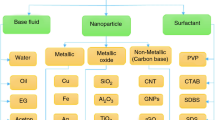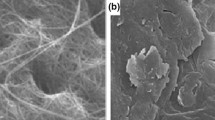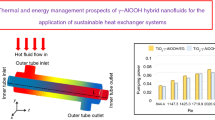Abstract
This work numerically investigates thermo-hydraulic and entropy generation characteristics of water-based graphene–silver (Gr–Ag) hybrid nanofluid with temperature-dependent properties in recharging microchannel (RMC). The thermal, hydraulic, and entropy generation characteristics in recharging microchannel are examined for different nanofluid volume concentrations and inlet velocity. The outcome of this study reveals that the utilization of Gr–Ag hybrid nanofluid in recharging microchannel enhances heat transfer performance. With an increase in both nanofluid volume concentration and fluid inlet velocity, substrate maximum temperature and thermal resistance decrease, whereas the uniformity in temperature distribution and average heat transfer coefficient enhanced. Moreover, the use of hybrid nanofluid in recharging microchannel shows higher pressure drop and requires more pumping power. Recharging microchannel (RMC) exhibits better overall performance compared to simple microchannel (SMC) with maximum performance factor value of 1.72. Further, frictional entropy generation increases, and thermal entropy generation decreases with increasing nanofluid volume concentration and inlet velocity. Both total entropy generation and Bejan number decrease with nanofluid volume concentration. Overall, the use of recharging microchannel (RMC) can be beneficial for high heat flux removal applications from both first and second law of thermodynamics perspective. Second, the utilization of water-based Gr–Ag hybrid nanofluid is beneficial when pumping power is not a constraint.


















Similar content being viewed by others
Abbreviations
- Be:
-
Bejan number
- C p :
-
Specific heat (J kg−1K−1)
- D h :
-
Hydraulic diameter (mm)
- e :
-
Percentage error (%)
- f avg :
-
Average friction factor
- h z :
-
Local convective heat transfer coefficient (W m−2K−1)
- h avg :
-
Average convective heat transfer coefficient (W m−2K−1)
- H :
-
Substrate thickness (mm)
- H c :
-
Channel height (mm)
- H cp :
-
Cover plate thickness (mm)
- k :
-
Thermal conductivity (W m−1K−1)
- k eff :
-
Effective thermal conductivity (W m−1K−1)
- L :
-
Substrate length (mm)
- L tw :
-
Transverse wall length (mm)
- ṁ :
-
Mass flow rate (kg s−1)
- N S :
-
Entropy generation enhancement number
- Nuz :
-
Local Nusselt number
- Nuavg :
-
Average Nusselt number
- p :
-
Pressure (N m−2)
- Δp :
-
Pressure drop (N m−2)
- PF:
-
Performance factor
- q″:
-
Applied heat flux at the substrate bottom surface (W m−2)
- \(q_{\text{z}}^{\prime \prime }\) :
-
Local heat flux (W m−2)
- R Th :
-
Thermal resistance (K W−1)
- \(S^{\prime\prime\prime}_{\text{G,F}}\) :
-
Local frictional entropy generation (W m−3K−1)
- \(S^{\prime\prime\prime}_{\text{G,T}}\) :
-
Local thermal entropy generation (W m−3K−1)
- \(S^{\prime\prime\prime}_{\text{G}}\) :
-
Local total entropy generation (W m−3K−1)
- S G,F :
-
Global frictional entropy generation (W K−1)
- S G,T :
-
Global thermal entropy generation (W K−1)
- S G :
-
Global total entropy generation (W K−1)
- T :
-
Temperature (K)
- T f :
-
Fluid temperature (K)
- T in :
-
Fluid inlet temperature (K)
- T max :
-
Maximum substrate temperature (K)
- T min :
-
Minimum substrate temperature (K)
- T s :
-
Solid substrate temperature (K)
- T w :
-
Wall temperature (K)
- v :
-
Fluid velocity at inlet (m s−1)
- V̇ :
-
Volume flow rate (m3 s−1)
- \(\overrightarrow {V}\) :
-
Velocity vector (m s−1)
- W c :
-
Channel width (mm)
- W :
-
Substrate width (mm)
- z :
-
Axial distance along the flow direction (mm)
- θ :
-
Cooling uniformity (Km2 W−1)
- μ :
-
Dynamic viscosity (kg m−1 s−1)
- ρ :
-
Density (kg m−3)
- ϕ :
-
Nanofluid volume concentration (%)
- Ω :
-
Pumping power (W)
- avg:
-
Average
- bf:
-
Base fluid
- bs:
-
Bottom surface of substrate
- c:
-
Channel
- cp:
-
Cover plate
- f:
-
Working fluid
- Hynf:
-
Hybrid nanofluid
- in:
-
Inlet
- nf:
-
Nanofluid
- p:
-
Nanoparticle
- s:
-
Solid
- tw:
-
Transverse wall
- CFD:
-
Computational fluid dynamics
- FVM:
-
Finite volume method
- GNP:
-
Graphene nanoplatelets
- MCHS:
-
Microchannel heat sink
- PMMA:
-
Poly methyl methacrylate
- RMC:
-
Recharging microchannel
- SMC:
-
Simple microchannel
References
Karayiannis TG, Mahmoud MM. Flow boiling in microchannels: fundamentals and applications. Appl Therm Eng. 2017. https://doi.org/10.1016/j.applthermaleng.2016.08.063.
Kandlikar SG, Garimella S, Li D, Colin S, King MR. Heat transfer and fluid flow in minichannels and microchannels. Waltham: Elsevier; 2005.
Tuckerman DB, Pease RFW. High-performance heat sinking for VLSI. IEEE Electron Device Lett. 1981. https://doi.org/10.1109/EDL.1981.25367.
Peng XF, Peterson GP. Convective heat transfer and flow friction for water flow in microchannel structures. Int J Heat Mass Transf. 1996. https://doi.org/10.1016/0017-9310(95)00327-4.
Lee PS, Garimella SV, Liu D. Investigation of heat transfer in rectangular microchannels. Int J Heat Mass Transf. 2005. https://doi.org/10.1016/j.ijheatmasstransfer.2004.11.019.
Lee PS, Garimella SV. Thermally developing flow and heat transfer in rectangular microchannels of different aspect ratios. Int J Heat Mass Transf. 2006. https://doi.org/10.1016/j.ijheatmasstransfer.2006.02.011.
Qu W, Mala GM, Li D. Heat transfer for water flow in trapezoidal silicon microchannels. Int J Heat Mass Transf. 2000. https://doi.org/10.1016/S0017-9310(00)00045-4.
Owhaib W, Palm B. Experimental investigation of single-phase convective heat transfer in circular microchannels. Exp Therm Fluid Sci. 2004. https://doi.org/10.1016/S0894-1777(03)00028-1.
Gunnasegaran P, Mohammed HA, Shuaib NH, Saidur R. The effect of geometrical parameters on heat transfer characteristics of microchannels heat sink with different shapes. Int Commun Heat Mass Transf. 2010. https://doi.org/10.1016/j.icheatmasstransfer.2010.06.014.
Salimpour MR, Sharifhasan M, Shirani E. Constructal optimization of microchannel heat sinks with noncircular cross sections. Heat Transf Eng. 2013. https://doi.org/10.1080/01457632.2012.746552.
Steinke ME, Kandlikar SG. Review of single-phase heat transfer enhancement techniques for application in microchannels, minichannels and microdevices. Int J Heat Technol. 2004. https://doi.org/10.18280/ijht220201.
Ghani IA, Sidik NAC, Kamaruzaman N. Hydrothermal performance of microchannel heat sink: the effect of channel design. Int J Heat Mass Transf. 2017. https://doi.org/10.1016/j.ijheatmasstransfer.2016.11.031.
Li Y, Xia G, Jia Y, Ma D, Cai B, Wang J. Effect of geometric configuration on the laminar flow and heat transfer in microchannel heat sinks with cavities and fins. Numer Heat Transf Part A Appl. 2017. https://doi.org/10.1080/10407782.2016.1277940.
Ghani IA, Kamaruzaman N, Sidik NAC. Heat transfer augmentation in a microchannel heat sink with sinusoidal cavities and rectangular ribs. Int J Heat Mass Transf. 2017. https://doi.org/10.1016/j.ijheatmasstransfer.2017.01.046.
Xu JL, Gan YH, Zhang DC, Li XH. Microscale heat transfer enhancement using thermal boundary layer redeveloping concept. Int J Heat Mass Transf. 2005. https://doi.org/10.1016/j.ijheatmasstransfer.2004.12.008.
Xu J, Song Y, Zhang W, Zhang H, Gan Y. Numerical simulations of interrupted and conventional microchannel heat sinks. Int J Heat Mass Transf. 2008. https://doi.org/10.1016/j.ijheatmasstransfer.2008.05.003.
Huang X, Yang W, Ming T, Shen W, Yu X. Heat transfer enhancement on a microchannel heat sink with impinging jets and dimples. Int J Heat Mass Transf. 2017. https://doi.org/10.1016/j.ijheatmasstransfer.2017.04.078.
Gan T, Ming T, Fang W, Liu Y, Miao L, Ren K, Ahmadi MH. Heat transfer enhancement of a microchannel heat sink with the combination of impinging jets, dimples, and side outlets. J Therm Anal Calorim. 2019. https://doi.org/10.1007/s10973-019-08754-z.
Kim CB, Leng C, Wang XD, Wang TH, Yan WM. Effects of slot-jet length on the cooling performance of hybrid microchannel/slot-jet module. Int J Heat Mass Transf. 2015. https://doi.org/10.1016/j.ijheatmasstransfer.2015.05.108.
Zhang Y, Wang S, Ding P. Effects of channel shape on the cooling performance of hybrid micro-channel and slot-jet module. Int J Heat Mass Transf. 2017. https://doi.org/10.1016/j.ijheatmasstransfer.2017.05.092.
Samal SK, Moharana MK. Thermo-hydraulic performance evaluation of a novel design recharging microchannel. Int J Therm Sci. 2019. https://doi.org/10.1016/j.ijthermalsci.2018.09.006.
Hussien AA, Abdullah MZ, Moh’d AAN. Single-phase heat transfer enhancement in micro/minichannels using nanofluids: theory and applications. Appl Energy. 2016. https://doi.org/10.1016/j.apenergy.2015.11.099.
Colangelo G, Favale E, Milanese M, de Risi A, Laforgia D. Cooling of electronic devices: nanofluids contribution. Appl Therm Eng. 2017. https://doi.org/10.1016/j.applthermaleng.2017.08.042.
Chamkha AJ, Molana M, Rahnama A, Ghadami F. On the nanofluids applications in microchannels: a comprehensive review. Powder Technol. 2018. https://doi.org/10.1016/j.powtec.2018.03.044.
Bahiraei M, Heshmatian S. Electronics cooling with nanofluids: a critical review. Energy Convers Manag. 2018. https://doi.org/10.1016/j.enconman.2018.07.047.
Sadeghinezhad E, Mehrali M, Saidur R, Mehrali M, Latibari ST, Akhiani AR, Metselaar HSC. A comprehensive review on graphene nanofluids: recent research, development and applications. Energy Convers Manag. 2016. https://doi.org/10.1016/j.enconman.2016.01.004.
Amiri A, Sadri R, Shanbedi M, Ahmadi G, Chew BT, Kazi SN, Dahari M. Performance dependence of thermosyphon on the functionalization approaches: an experimental study on thermo-physical properties of graphene nanoplatelet-based water nanofluids. Energy Convers Manag. 2015. https://doi.org/10.1016/j.enconman.2014.12.051.
Akhavan-Zanjani H, Saffar-Avval M, Mansourkiaei M, Sharif F, Ahadi M. Experimental investigation of laminar forced convective heat transfer of graphene–water nanofluid inside a circular tube. Int J Therm Sci. 2016. https://doi.org/10.1016/j.ijthermalsci.2015.10.003.
Yarmand H, Gharehkhani S, Shirazi SFS, Amiri A, Alehashem MS, Dahari M, Kazi SN. Experimental investigation of thermo-physical properties, convective heat transfer and pressure drop of functionalized graphene nanoplatelets aqueous nanofluid in a square heated pipe. Energy Convers Manag. 2016. https://doi.org/10.1016/j.enconman.2016.02.008.
Khodabandeh E, Rozati SA, Joshaghani M, Akbari OA, Akbari S, Toghraie D. Thermal performance improvement in water nanofluid/GNP–SDBS in novel design of double-layer microchannel heat sink with sinusoidal cavities and rectangular ribs. J Therm Anal Calorim. 2019. https://doi.org/10.1007/s10973-018-7826-2.
Akbari OA, Khodabandeh E, Kahbandeh F, Toghraie D, Khalili M. Numerical investigation of heat transfer of nanofluid flow through a microchannel with heat sinks and sinusoidal cavities by using novel nozzle structure. J Therm Anal Calorim. 2019. https://doi.org/10.1007/s10973-019-08227-3.
Ranjbarzadeh R, Karimipour A, Afrand M, Isfahani AHM, Shirneshan A. Empirical analysis of heat transfer and friction factor of water/graphene oxide nanofluid flow in turbulent regime through an isothermal pipe. Appl Therm Eng. 2017. https://doi.org/10.1016/j.applthermaleng.2017.07.189.
Sadri R, Hosseini M, Kazi SN, Bagheri S, Ahmed SM, Ahmadi G, Zubir N, Sayuti M, Dahari M. Study of environmentally friendly and facile functionalization of graphene nanoplatelet and its application in convective heat transfer. Energy Convers Manag. 2017. https://doi.org/10.1016/j.enconman.2017.07.036.
Esfahani MR, Nunna MR, Languri EM, Nawaz K, Cunningham G. Experimental study on heat transfer and pressure drop of in-house synthesized graphene oxide nanofluids. Heat Transf Eng. 2018. https://doi.org/10.1080/01457632.2018.1497001.
Yarmand H, Gharehkhani S, Ahmadi G, Shirazi SFS, Baradaran S, Montazer E, Zubir MNM, Alehashem MS, Kazi SN, Dahari M. Graphene nanoplatelets–silver hybrid nanofluids for enhanced heat transfer. Energy Convers Manag. 2015. https://doi.org/10.1016/j.enconman.2015.05.023.
Bahiraei M, Heshmatian S. Efficacy of a novel liquid block working with a nanofluid containing graphene nanoplatelets decorated with silver nanoparticles compared with conventional CPU coolers. Appl Therm Eng. 2017. https://doi.org/10.1016/j.applthermaleng.2017.08.136.
Bahiraei M, Heshmatian S. Thermal performance and second law characteristics of two new microchannel heat sinks operated with hybrid nanofluid containing graphene–silver nanoparticles. Energy Convers Manag. 2018. https://doi.org/10.1016/j.enconman.2018.05.020.
Bahiraei M, Jamshidmofid M, Goodarzi M. Efficacy of a hybrid nanofluid in a new microchannel heat sink equipped with both secondary channels and ribs. J Mol Liq. 2019. https://doi.org/10.1016/j.molliq.2018.10.003.
Mahian O, Kianifar A, Kleinstreuer C, Moh’d AAN, Pop I, Sahin AZ, Wongwises S. A review of entropy generation in nanofluid flow. Int J Heat Mass Transf. 2013. https://doi.org/10.1016/j.ijheatmasstransfer.2013.06.010.
Awad MM. A review of entropy generation in microchannels. Adv Mech Eng. 2015. https://doi.org/10.1177/1687814015590297.
Mehrali M, Sadeghinezhad E, Rosen MA, Akhiani AR, Latibari ST, Mehrali M, Metselaar HSC. Heat transfer and entropy generation for laminar forced convection flow of graphene nanoplatelets nanofluids in a horizontal tube. Int Commun Heat Mass Transf. 2015. https://doi.org/10.1016/j.icheatmasstransfer.2015.05.007.
Ebrahimi A, Rikhtegar F, Sabaghan A, Roohi E. Heat transfer and entropy generation in a microchannel with longitudinal vortex generators using nanofluids. Energy. 2016. https://doi.org/10.1016/j.energy.2016.01.102.
Ahammed N, Asirvatham LG, Wongwises S. Entropy generation analysis of graphene–alumina hybrid nanofluid in multiport minichannel heat exchanger coupled with thermoelectric cooler. Int J Heat Mass Transf. 2016. https://doi.org/10.1016/j.ijheatmasstransfer.2016.07.070.
Sheikholeslami M, Jafaryar M, Shafee A, Li Z. Nanofluid heat transfer and entropy generation through a heat exchanger considering a new turbulator and CuO nanoparticles. J Therm Anal Calorim. 2018. https://doi.org/10.1007/s10973-018-7866-7.
Manay E, Akyürek EF, Sahin B. Entropy generation of nanofluid flow in a microchannel heat sink. Results Phys. 2018. https://doi.org/10.1016/j.rinp.2018.03.013.
Darbari B, Rashidi S, Keshmiri A. Nanofluid heat transfer and entropy generation inside a triangular duct equipped with delta winglet vortex generators. J Therm Anal Calorim. 2019. https://doi.org/10.1007/s10973-019-08382-7.
Al-Rashed AAAA, Shahsavar A, Rasooli O, Moghimi MA, Karimipour A, Tran MD. Numerical assessment into the hydrothermal and entropy generation characteristics of biological water-silver nano-fluid in a wavy walled microchannel heat sink. Int Commun Heat Mass Transf. 2019. https://doi.org/10.1016/j.icheatmasstransfer.2019.03.007.
Bejan A. Entropy generation through heat and fluid flow. New York: Willey; 1982.
Guo J, Xu M, Cheng L. Second law analysis of curved rectangular channels. Int J Therm Sci. 2011. https://doi.org/10.1016/j.ijthermalsci.2010.12.011.
Lee J, Mudawar I. Assessment of the effectiveness of nanofluids for single-phase and two-phase heat transfer in micro-channels. Int J Heat Mass Transf. 2007. https://doi.org/10.1016/j.ijheatmasstransfer.2006.08.001.
Li J, Kleinstreuer C. Entropy generation analysis for nanofluid flow in microchannels. ASME J Heat Transf. 2010. https://doi.org/10.1115/1.4002395.
Author information
Authors and Affiliations
Corresponding author
Ethics declarations
Conflict of interest
The authors declare that they have no conflict of interest.
Additional information
Publisher's Note
Springer Nature remains neutral with regard to jurisdictional claims in published maps and institutional affiliations.
Rights and permissions
About this article
Cite this article
Samal, S.K., Moharana, M.K. Thermo-hydraulic and entropy generation analysis of recharging microchannel using water-based graphene–silver hybrid nanofluid. J Therm Anal Calorim 143, 4131–4148 (2021). https://doi.org/10.1007/s10973-020-09382-8
Received:
Accepted:
Published:
Issue Date:
DOI: https://doi.org/10.1007/s10973-020-09382-8




